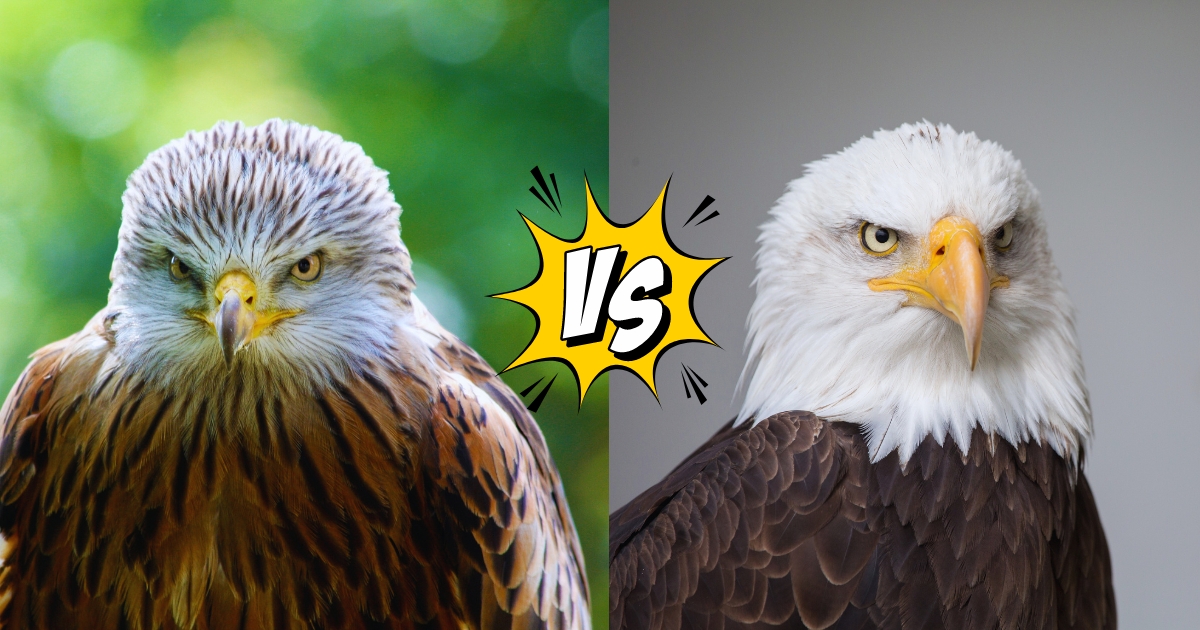Soaring high above, with their powerful wings spread wide and their sharp eyes scanning the landscape below, hawks and eagles command respect and awe. These magnificent birds of prey are among the most impressive hunters in the skies, each possessing unique abilities and characteristics that make them formidable predators. In this article, we’ll delve into the epic battle between hawks and eagles, exploring their physical traits, hunting techniques, habitats, behaviors, and conservation status.
As we embark on this journey, we’ll uncover the remarkable similarities and distinct differences between these two avian giants, shedding light on their place in the natural world and the importance of preserving their populations. So, buckle up and get ready to witness an aerial spectacle like no other – hawk vs eagle in all its glory.
Physical Characteristics
Hawks
Hawks are medium-sized raptors, typically ranging from 16 to 25 inches in length and with a wingspan of 3 to 4 feet. Their streamlined bodies and sharp, hooked beaks are designed for aerial agility and efficient hunting. Hawks possess powerful talons, which they use to capture and subdue their prey with precision.
One of the most distinctive features of hawks is their broad, rounded wings, which allow them to maneuver swiftly and change directions with ease. Their excellent eyesight and keen senses also contribute to their hunting prowess, enabling them to spot prey from great distances and react quickly.
Eagles
Eagles, on the other hand, are larger and more imposing birds of prey. With a length ranging from 28 to 40 inches and a wingspan spanning 6 to 8 feet, they command an impressive presence in the skies. Their massive beaks and razor-sharp talons are formidable weapons, capable of tearing through even the toughest of prey.
Eagles are known for their broad, flat wings, which provide them with exceptional soaring abilities and allow them to glide effortlessly on thermal currents. Their keen eyesight, combined with their powerful beaks and talons, make them apex predators in their respective habitats.
Similarities and Differences
While hawks and eagles share some similarities, such as their predatory nature and remarkable eyesight, they also possess distinct differences. Eagles are generally larger and more powerful, with a greater wingspan and stronger talons, making them better suited for hunting larger prey. Hawks, on the other hand, are more agile and maneuverable, excelling at swift aerial pursuits and capturing smaller prey.
Both birds are equipped with sharp beaks and talons, but the beak of an eagle is generally more massive and hooked, while a hawk’s beak is more slender and curved. Additionally, eagles typically have a more pronounced crest of feathers on their heads, giving them a regal appearance.
Hunting Techniques
Hawks
Hawks are skilled hunters, employing a variety of techniques to capture their prey. One of their most common hunting methods is known as “stooping,” where they spot their target from a great height and dive towards it at incredible speeds, using their powerful talons to seize the prey.
Another technique used by hawks is “soaring,” where they glide effortlessly on thermal currents, conserving energy while keeping a watchful eye for any potential meals below. Some hawk species also engage in “kiting,” a hunting strategy where they hover in one spot, facing into the wind, and scan the ground for movement.
Eagles
Eagles, with their massive size and strength, employ different hunting techniques than their smaller cousins, the hawks. One of their primary methods is “still-hunting,” where they perch patiently on a high vantage point, such as a tree or cliff, and wait for prey to appear below.
Eagles are also known for their impressive aerial hunting abilities, utilizing their broad wings and powerful talons to snatch prey from the air or pluck fish from the water’s surface. Some eagle species, like the Bald Eagle, are skilled at “piracy,” where they steal prey from other birds or even snatch animals from the water’s surface.
Comparison of Hunting Abilities
While both hawks and eagles are formidable hunters, their hunting abilities are tailored to their respective strengths and prey preferences. Hawks excel at swift aerial pursuits and capturing smaller prey, such as rodents, birds, and insects, thanks to their agility and maneuverability.
Eagles, on the other hand, are better suited for hunting larger prey, such as rabbits, foxes, and even deer or goats, due to their immense size and powerful talons. Their ability to soar effortlessly at great heights also allows them to survey vast areas and spot potential prey from afar.
However, it’s important to note that some species of hawks and eagles may have overlapping hunting techniques and prey preferences, depending on their specific habitat and available resources.
Habitat and Distribution
Hawks
Hawks can be found in a variety of habitats, from dense forests and woodlands to open grasslands and urban areas. Different species of hawks have adapted to specific environments, with some preferring coastal regions, deserts, or mountainous terrain.
Geographically, hawks are widely distributed across the globe, with species found on every continent except Antarctica. Some of the most well-known hawk species include the Red-tailed Hawk, Cooper’s Hawk, and the Sharp-shinned Hawk, which are commonly found in North America.
Eagles
Eagles are typically found in more remote and wilderness areas, such as mountainous regions, coastal areas, and forests. They prefer habitats with access to open spaces for hunting and nesting, as well as proximity to water sources for fishing.
In terms of distribution, eagles are found on every continent except Antarctica, with different species occupying various regions. For example, the Bald Eagle is primarily found in North America, while the Golden Eagle has a more widespread distribution across Europe, Asia, and North America.
Overlapping Territories
While hawks and eagles often occupy distinct habitats, there are instances where their territories overlap. In these cases, competition for resources and territorial disputes may arise, especially if the prey preferences of the two species coincide.
These overlapping territories can lead to fascinating interactions and power struggles, as hawks and eagles vie for dominance in shared hunting grounds or nesting areas. Understanding these territorial dynamics is crucial for effective conservation efforts and maintaining a balanced ecosystem.
Behavior and Characteristics
Hawks
Hawks exhibit a range of behaviors and characteristics that contribute to their survival and reproductive success. Many hawk species are solitary hunters, but some may form loose associations or even engage in cooperative hunting.
When it comes to nesting, hawks typically build their nests in tall trees, on cliffs, or on human-made structures like buildings or utility poles. They are known for their distinctive vocalizations, which can range from high-pitched whistles to loud, raucous calls, depending on the species.
Eagles
Eagles are often depicted as majestic and powerful birds, with behaviors that reflect their dominance in the skies. They are typically solitary hunters, although some species may form pairs or small family groups.
Nesting is a critical aspect of eagle behavior, with pairs often returning to the same nest year after year, reinforcing and adding materials to create massive structures. Eagles are known for their iconic vocalizations, which can include piercing cries and resonant calls that echo through their habitats.
Territorial Disputes and Dominance
Both hawks and eagles are fiercely territorial, defending their hunting grounds and nesting sites from potential rivals. When their territories overlap, conflicts can arise, leading to aerial displays of dominance and, in some cases, physical confrontations.
During these territorial disputes, the larger and more powerful eagles often have the upper hand, using their size and strength to assert their dominance over hawks. However, hawks are not to be underestimated, as their agility and speed can sometimes give them an advantage in aerial battles.
These territorial clashes are not only fascinating to witness but also play a crucial role in maintaining the balance of predator-prey relationships within ecosystems.
Conservation Status
Hawks
The conservation status of hawks varies among different species and regions. Some hawk populations have been impacted by habitat loss, pesticide use, and illegal hunting or trapping.
Conservation efforts for hawks often involve protecting and restoring their natural habitats, implementing sustainable land management practices, and raising awareness about the importance of these birds in maintaining healthy ecosystems.
Eagles
Eagles have historically faced numerous threats, including habitat destruction, hunting, and the use of pesticides like DDT, which nearly caused the extinction of the Bald Eagle in the United States. However, through concerted conservation efforts and legal protections, many eagle populations have made remarkable recoveries.
Ongoing conservation measures for eagles include habitat preservation, nest monitoring, and public education campaigns to promote coexistence with these magnificent birds of prey.
Importance of Preserving These Magnificent Birds
Preserving both hawks and eagles is crucial for maintaining the delicate balance of ecosystems and biodiversity. As apex predators, these birds play a vital role in controlling prey populations and promoting a healthy food chain.
Additionally, hawks and eagles hold significant cultural and symbolic importance in many societies, representing strength, freedom, and a connection to the natural world. By protecting these magnificent birds, we not only safeguard their future but also preserve a part of our shared heritage and ensure that future generations can witness their beauty and power in the skies.
People Also Read:
Conclusion
In the epic battle between hawks and eagles, it becomes evident that these remarkable birds of prey are both fierce competitors and vital components of our natural world. While they possess distinct physical characteristics, hunting techniques, and behaviors, they share a common thread – the ability to inspire awe and wonder in those who witness their aerial prowess.
As we continue to explore and appreciate the intricate relationships between these avian predators, it is our responsibility to ensure their survival and conservation. By preserving their habitats, promoting sustainable practices, and raising awareness about their importance, we can ensure that the skies remain filled with the majestic presence of hawks and eagles for generations to come.
Remember, these birds are not just mere creatures – they are living symbols of the wild, untamed beauty that exists in our world. So, let us embrace the epic battle between hawks and eagles, and let it serve as a reminder of the need to protect and cherish the wonders of nature that surround us.
FAQs
What is the main difference between a hawk and an eagle?
The main difference between hawks and eagles lies in their size and hunting techniques. Hawks are typically smaller and more agile, excelling at swift aerial pursuits and capturing smaller prey, while eagles are larger and more powerful, capable of hunting larger prey and soaring effortlessly on thermal currents.
Can hawks and eagles interbreed?
No, hawks and eagles cannot interbreed. They belong to different genera and species, and interbreeding between them is not possible. Their genetic makeup and physical characteristics are too distinct to produce viable offspring.
Which is faster, a hawk or an eagle?
In general, hawks are considered faster flyers than eagles. Hawks have more streamlined bodies and wings that are designed for agility and speed, allowing them to reach incredible speeds during dives and aerial pursuits. Eagles, on the other hand, are built for strength and soaring, rather than outright speed.
Are hawks and eagles endangered?
The conservation status of hawks and eagles varies depending on the species and region. While some populations are thriving, others are listed as endangered or threatened due to factors like habitat loss, illegal hunting, and pesticide use. Ongoing conservation efforts are crucial to protect these magnificent birds of prey.
How can I help conserve hawks and eagles?
There are several ways you can contribute to the conservation of hawks and eagles:
- Support organizations and initiatives dedicated to protecting these birds and their habitats.
- Educate yourself and others about the importance of these predators in the ecosystem.
- Advocate for sustainable land management practices and policies that protect their habitats.
- Report any illegal hunting or disturbance of nesting sites to the appropriate authorities.
- Participate in citizen science projects that monitor hawk and eagle populations.

